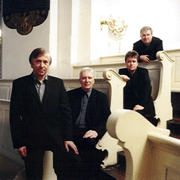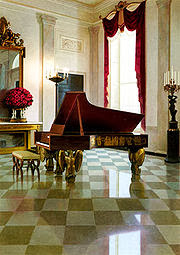In Review--Hilliard Ensemble
photo: by Friedrun Reinhold
The Hilliard Ensemble
Thomas Tallis, Christopher Tye and John Sheppard
ECM
I learned about The Hilliard Ensemble through a Seattle-based early music ensemble, The Tudor Choir. And through this choir, I also heard about the music of Thomas Tallis and John Sheppard, if I am not mistaken. This will be the second Hilliard Ensemble recording reviewed by me (the other review appears on Cranky Crow Whole Music).
While this recording is important for historical reasons as well as, the sheer beauty of the seamless voices of David James (countertenor), Rogers Covey-Crump (tenor), Steven Harrold (tenor), Gordon Jones (baritone) and Robert Macdonald (bass), I will ask you to read the scholarly liner notes which delve into that history. If you are interested in 16th century England, then your delight will double as you read about the renaissance composers and the events that surrounded them.
Religious music turns some people off, which given all the dogma people are faced with in their lives, is understandable. However, renaissance polyphony with its antiphons and lush counterpoint (harmonies), is breathtaking in my opinion. Hearing this music performed in a cathedral or even in a home with tall ceilings can be extremely healing--just feeling the vibrations alone must be.
This latest offering by The Hilliard Ensemble starts off with three pieces by Thomas Tallis, with the titular track proving the spectacularity of this music. The liner notes cite, "The respond Audivi vocem probably dates back from the end of Henry VIII's reign. The work served as a specific liturgical purpose at Matins on the feast of All Saints' Day." The notes mention the ritual of altar boys with their heads covered and carrying white candles as they proceeded to the altar.
The works of John Sheppard and Christopher Tye also offer musical innovations of their time. And while we are far removed from 16th century England, renaissance polyphony still holds a place in some of our hearts. Yes, it is the music of the Christian church, but even contemporary Christians do not attend these renaissance concerts regularly or even purchase the recordings--religious music has changed since that era. Viewed as historical music with a mark of beauty might be the best approach and if you feel spirit move you while listening to this music, then more power to you. The original intention of the music was to create such an atmosphere where Spirit would dwell.
I personally find renaissance polyphony calming and exhilarating. This recording is another achievement by the formidable Hilliard Ensemble. If you are a follower of this ensemble already then you do not want to miss this recording and if you are not, give it a listen.
ECM
The Hilliard Ensemble
Thomas Tallis, Christopher Tye and John Sheppard
ECM
I learned about The Hilliard Ensemble through a Seattle-based early music ensemble, The Tudor Choir. And through this choir, I also heard about the music of Thomas Tallis and John Sheppard, if I am not mistaken. This will be the second Hilliard Ensemble recording reviewed by me (the other review appears on Cranky Crow Whole Music).
While this recording is important for historical reasons as well as, the sheer beauty of the seamless voices of David James (countertenor), Rogers Covey-Crump (tenor), Steven Harrold (tenor), Gordon Jones (baritone) and Robert Macdonald (bass), I will ask you to read the scholarly liner notes which delve into that history. If you are interested in 16th century England, then your delight will double as you read about the renaissance composers and the events that surrounded them.
Religious music turns some people off, which given all the dogma people are faced with in their lives, is understandable. However, renaissance polyphony with its antiphons and lush counterpoint (harmonies), is breathtaking in my opinion. Hearing this music performed in a cathedral or even in a home with tall ceilings can be extremely healing--just feeling the vibrations alone must be.
This latest offering by The Hilliard Ensemble starts off with three pieces by Thomas Tallis, with the titular track proving the spectacularity of this music. The liner notes cite, "The respond Audivi vocem probably dates back from the end of Henry VIII's reign. The work served as a specific liturgical purpose at Matins on the feast of All Saints' Day." The notes mention the ritual of altar boys with their heads covered and carrying white candles as they proceeded to the altar.
The works of John Sheppard and Christopher Tye also offer musical innovations of their time. And while we are far removed from 16th century England, renaissance polyphony still holds a place in some of our hearts. Yes, it is the music of the Christian church, but even contemporary Christians do not attend these renaissance concerts regularly or even purchase the recordings--religious music has changed since that era. Viewed as historical music with a mark of beauty might be the best approach and if you feel spirit move you while listening to this music, then more power to you. The original intention of the music was to create such an atmosphere where Spirit would dwell.
I personally find renaissance polyphony calming and exhilarating. This recording is another achievement by the formidable Hilliard Ensemble. If you are a follower of this ensemble already then you do not want to miss this recording and if you are not, give it a listen.
ECM




Comments
Post a Comment